Hydrogeophysical Characterization of Fractured Aquifers for Groundwater Exploration in the Federal District of Brazil
Abstract
1. Introduction
2. Materials and Methods
2.1. Study Area
2.2. R3/Q3 Aquifer Sub-System
2.3. Electrical Resistivity Tomography (ERT)
2.4. Data Acquisition and Processing
3. Results and Discussion
3.1. Analysis of ERT Data and Overview of the Findings
3.2. Resistivity Inversion Models and Geological Features
4. Discussion
5. Conclusions and Recommendations
Author Contributions
Funding
Institutional Review Board Statement
Informed Consent Statement
Data Availability Statement
Acknowledgments
Conflicts of Interest
References
- Lorz, C.; Abbt-Braun, G.; Bakker, F.; Borges, P.; Börnick, H.; Fortes, L.; Frimmel, F.H.; Gaffron, A.; Hebben, N.; Höfer, R.; et al. Challenges of an integrated water resource management for the Distrito Federal, Western Central Brazil: Climate, land-use and water resources. Environ. Earth Sci. 2012, 65, 1575–1586. [Google Scholar] [CrossRef]
- Nunes, L.M.G.; Lucena, L.R.F.D.; Silva, C.C.N.D. Reserve evaluation of a fault-conditioned aquifer: The Barreiras Aquifer in the coastal region of NE Brazil. Braz. J. Geol. 2020, 50. Available online: https://www.scielo.br/j/bjgeo/a/yyrTjbQSg3W5qkcMzqHfqQC/?lang=en (accessed on 19 September 2021). [CrossRef]
- ADASA, Avaliação de aquíferos favoráveis para complementação ementação do abastecimento de água no distrito federal e locação de poços tubulares profundos: Profundos regiões atendidas e não atendidas pelo sistema integrado descoberto de—Santa Maria/torto. 2017. Available online: https://www.adasa.df.gov.br/ (accessed on 1 May 2021).
- Kuznetsov, M.; Viero, A.P.; Sorek, S.; Roisenberg, A.; Ronen, D. Modeling the Flow Pattern at the Fractured Granites in Porto Alegre, Brazil. Transp. Porous Media 2014, 101, 413–436. [Google Scholar] [CrossRef]
- Hussain, Y.; Uagoda, R.; Borges, W.; Susanne, M.; Hamza, O.; Havenith, H.-B. Estimation of total groundwater reserves and delineation of weathered/fault zones for aquifer potential: A case study of Federal District—Brazil. Open Geosci. 2021, 13, 1–13. [Google Scholar] [CrossRef]
- Comte, J.-C.; Cassidy, R.; Nitsche, J.; Ofterdinger, U.; Pilatova, K.; Flynn, R. The typology of Irish hard-rock aquifers based on an integrated hydrogeological and geophysical approach. Hydrogeol. J. 2012, 20, 1569–1588. [Google Scholar] [CrossRef]
- Zhou, Q.Y.; Matsui, H.; Shimada, J. Characterization of the unsaturated zone around a cavity in fractured rocks using electrical resistivity tomography. J. Hydraul. Res. 2004, 42, 25–31. [Google Scholar] [CrossRef]
- Kumar, D.; Rao, V.A.; Sarma, V.S. Hydrogeological and geophysical study for deeper groundwater resource in quartzitic hard rock ridge region from 2D resistivity data. J. Earth Syst. Sci. 2014, 123, 531–543. [Google Scholar] [CrossRef]
- Junaid, M.; Abdullah, R.A.; Saa’Ri, R.; Alel, M.; Ali, W.; Ullah, A. Recognition of boulder in granite deposit using integrated borehole and 2D electrical resistivity imaging for effective mine planning and development. Bull. Geol. Soc. Malays. 2019, 67, 99–104. [Google Scholar] [CrossRef]
- Briški, M.; Stroj, A.; Kosović, I.; Borović, S. Characterization of Aquifers in Metamorphic Rocks by Combined Use of Electrical Resistivity Tomography and Monitoring of Spring Hydrodynamics. Geosciences 2020, 10, 137. [Google Scholar] [CrossRef]
- De Lucena, L.R.F.; de Rosa Filho, E.F.; Hindi, E.C. O CONTROLE ESTRUTURAL NO AQÜÍFERO BARREIRAS—ÁREA DA BACIA DO RIO PIRANGI (RN). Águas Subterrâneas 2006, 20, 83–98. [Google Scholar] [CrossRef][Green Version]
- Soares, A.P.; Soares, P.C.; Bettú, D.F.; Holtz, M. VARIABILIDADE ESPACIAL NO SISTEMA AQÜÍFERO GUARANI: CONTROLES ESTRUTURAIS E ESTRATIGRÁFICOS. Águas Subterrâneas 2007, 21. [Google Scholar] [CrossRef]
- Rodrigues, M.A.C.; Lucena, L.R.F.; Souza, I.V.F. Preliminary geometric model of the Barreiras Aquifer derived from hydrogeophysics data at the River Catu basin, NE Brazil. In Proceedings of the 12th International Congress of the Brazilian Geophysical Society, Rio de Janeiro, Brazil, 15–18 August 2011. [Google Scholar]
- Lucena, L.R.F.; Oliveira, J.G., Jr.; Medeiros, W.E.; Queiroz, M.A. The potential of the Barreiras Aquifer in the lower course of the Doce River, Rio Grande do Norte State, Northeast Brazil—Integration of hydrogeologica land geophysical data. Braz. J. Geophys. 2013, 31, 43–57. [Google Scholar] [CrossRef]
- Burazer, M.; Žitko, V.; Radaković, D.; Parezanović, M. Using geophysical methods to define the attitude and extension of water-bearing strata in the Miocene sediments of the Pannonian Basin. J. Appl. Geophys. 2010, 72, 242–253. [Google Scholar] [CrossRef]
- Díaz, D.; Maksymowicz, A.; Vargas, G.; Vera, E.; Contreras-Reyes, E.; Rebolledo, S. Exploring the shallow structure of the San Ramón thrust fault in Santiago, Chile (~33.5° S), using active seismic and electric methods. Solid Earth 2014, 5, 837–849. [Google Scholar] [CrossRef]
- Zoby, J.L.; Duarte, U. Caracterização hidrogeológica da bacia do Ribeirão Sobradinho-Brasília (DF). Geologia USP Série Científica 2001, 1, 79–99. [Google Scholar] [CrossRef]
- Campos, J.E.G. Hidrogeologia do Distrito Federal: Bases para a gestão dos recursos hídricos subterrâneos. Braz. J. Geol. 2004, 34, 41–48. [Google Scholar] [CrossRef]
- Kotowski, T.; Chudzik, L.; Najman, J. Application of dissolved gases concentration measurements, hydrochemical and isotopic data to determine the circulation conditions and age of groundwater in the Central Sudetes Mts. J. Hydrol. 2019, 569, 735–752. [Google Scholar] [CrossRef]
- Campos, J.E.G.; Bogossian, J.; Carvalho, R.M. Sedimentology of the Psammo-pelitic-carbonate Unit, Paranoá Group, and Sete Lagoas Formation, Bambuí Group: Examples of mixed carbonate-siliciclastic sedimentation in the Proterozoic of the Brasília Fold Belt. Rev. Bras. Geociências 2012, 42, 513–522. [Google Scholar] [CrossRef]
- Gallas, J.D.F.; Taioli, F.; Filho, W.M. Induced polarization, resistivity, and self-potential: A case history of contamination evaluation due to landfill leakage. Environ. Earth Sci. 2011, 63, 251–261. [Google Scholar] [CrossRef]
- Hussain, Y.; Cardenas-Soto, M.; Martino, S.; Moreira, C.; Borges, W.; Hamza, O.; Prado, R.; Uagoda, R.; Rodríguez-Rebolledo, J.; Silva, R.C.; et al. Multiple Geophysical Techniques for Investigation and Monitoring of Sobradinho Landslide, Brazil. Sustainability 2019, 11, 6672. [Google Scholar] [CrossRef]
- Comte, J.-C.; Ofterdinger, U.; Legchenko, A.; Caulfield, J.; Cassidy, R.; González, J.A.M. Catchment-scale heterogeneity of flow and storage properties in a weathered/fractured hard rock aquifer from resistivity and magnetic resonance surveys: Implications for groundwater flow paths and the distribution of residence times. Geol. Soc. London Spec. Publ. 2019, 479, 35–58. [Google Scholar] [CrossRef]
- Cassidy, R.; Comte, J.-C.; Nitsche, J.; Wilson, C.; Flynn, R.; Ofterdinger, U. Combining multi-scale geophysical techniques for robust hydro-structural characterisation in catchments underlain by hard rock in post-glacial regions. J. Hydrol. 2014, 517, 715–731. [Google Scholar] [CrossRef]
- Donohue, S.; McCarthy, V.; Rafferty, P.; Orr, A.; Flynn, R. Geophysical and hydrogeological characterisation of the impacts of on-site wastewater treatment discharge to groundwater in a poorly productive bedrock aquifer. Sci. Total. Environ. 2015, 523, 109–119. [Google Scholar] [CrossRef] [PubMed]
- Orr, A.; Nitsche, J.; Archbold, M.; Deakin, J.; Ofterdinger, U.; Flynn, R. The influence of bedrock hydrogeology on catchment-scale nitrate fate and transport in fractured aquifers. Sci. Total. Environ. 2016, 569–570, 1040–1052. [Google Scholar] [CrossRef]
- Alle, I.C.; Descloitres, M.; Vouillamoz, J.-M.; Yalo, N.; Lawson, F.M.A.; Adihou, A.C. Why 1D electrical resistivity techniques can result in inaccurate siting of boreholes in hard rock aquifers and why electrical resistivity tomography must be preferred: The example of Benin, West Africa. J. Afr. Earth Sci. 2018, 139, 341–353. [Google Scholar] [CrossRef]
- Noorellimia, M.T.; Aimrun, W.; Azwan, M.M.Z.; Abdullah, A.F. Geoelectrical parameters for the estimation of hydrogeological properties. Arab. J. Geosci. 2019, 12, 62. [Google Scholar] [CrossRef]
- Lee, S.C.H.; Noh, K.A.M.; Zakariah, M.N.A. High-resolution electrical resistivity tomography and seismic refraction for groundwater exploration in fracture hard rocks: A case study in Kanthan, Perak, Malaysia. J. Asian Earth Sci. 2021, 218, 104880. [Google Scholar] [CrossRef]
- Pires, C.A.; Athayde, G.B.; de Souza Filho, O.A.; Ofterdinger, U. Litho-structural conditioning in the exploration of fractured aquifers: A case study in the Crystalline Basement Aquifer System of Brazil. Hydrogeol. J. 2021, 29, 1657–1678. [Google Scholar] [CrossRef]
- Lachassagne, P.; Wyns, R.; Dewandel, B. The fracture permeability of Hard Rock Aquifers is due neither to tectonics, nor to unloading, but to weathering processes. Terra Nova 2011, 23, 145–161. [Google Scholar] [CrossRef]
- Kumar, D. Efficacy of electrical resistivity tomography technique in mapping shallow subsurface anomaly. J. Geol. Soc. India 2012, 80, 304–307. [Google Scholar] [CrossRef]
- Zuber, A.; Motyka, J. Hydraulic parameters and solute velocities in triple-porosity karstic-fissured-porous carbonate aquifers: Case studies in southern Poland. Environ. Geol. 1998, 34, 243–250. [Google Scholar] [CrossRef]
- Motyka, J. A conceptual model of hydraulic networks in carbonate rocks, illustrated by examples from Poland. Hydrogeol. J. 1998, 6, 469–482. [Google Scholar] [CrossRef]
- Pilli, A.; Sapigni, M.; Zuppi, G.M. Karstic and alluvial aquifers: Conceptual model for the plain—Prealps system (northeastern Italy). J. of Hydrolo. 2012, 464–465, 94–106. [Google Scholar] [CrossRef]
- Adabanija, M.A.; Kolawole, L.L.; Afolabi, A.O.; Osinowo, O.O. Investigating aquifer structure in a low-latitude crystalline basement complex of southwestern Nigeria using radial vertical electrical sounding. Arab. J. Geosci. 2021, 14, 1–14. [Google Scholar] [CrossRef]
- Perrin, J.; Ahmed, S.; Hunkeler, D. The effects of geological heterogeneities and piezometric fluctuations on groundwater flow and chemistry in a hard-rock aquifer, southern India. Hydrogeol. J. 2011, 19, 1189–1201. [Google Scholar] [CrossRef]
- Pedrazas, M.A.; Hahm, W.J.; Dralle, D.; Nelson, M.D.; Breunig, R.E.; Fauria, K.E.; Bryk, A.B.; Dietrich, W.E.; Rempe, D.M. The relationship between topography, bedrock weathering, and water storage across a sequence of ridges and valleys. J. Geophys. Res. Earth Surf. 2021, 126, 217. [Google Scholar] [CrossRef]
- Kouamé, I.K.; Douagui, A.G.; Bouatrin, D.K.; Kouadio, S.K.A.; Savané, I. Assessing the hydrodynamic properties of the fissured layer of granitoid aquifers in the Tchologo Region (Northern Côte d’Ivoire). Heliyon 2021, 7, 07620. [Google Scholar] [CrossRef]
- Place, J.; Géraud, Y.; Diraison, M.; Herquel, G.; Edel, J.B.; Bano, M.; Le Garzic, E.; Walter, B. Structural control of weathering processes within exhumed granitoids: Compartmentalisation of geophysical properties by faults and fractures. J. Struct. Geol. 2016, 84, 102–119. [Google Scholar] [CrossRef]
- Figueroa, R.; Viguier, B.; Taucare, M.; Yáñez, G.; Arancibia, G.; Sanhueza, J.; Daniele, L. Deciphering groundwater flow-paths in fault-controlled semiarid mountain front zones (Central Chile). Sci. Total. Environ. 2021, 771, 145456. [Google Scholar] [CrossRef]

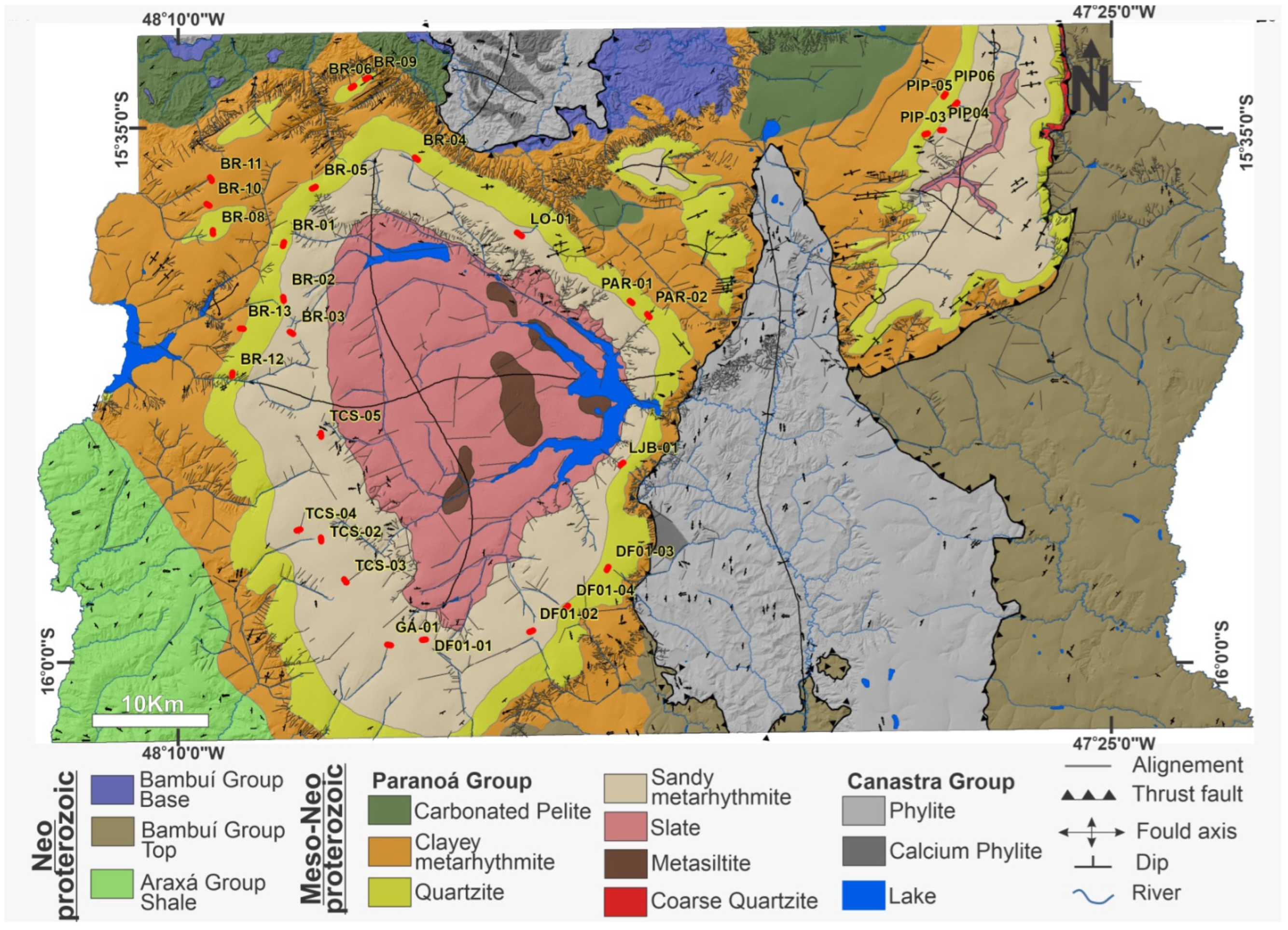
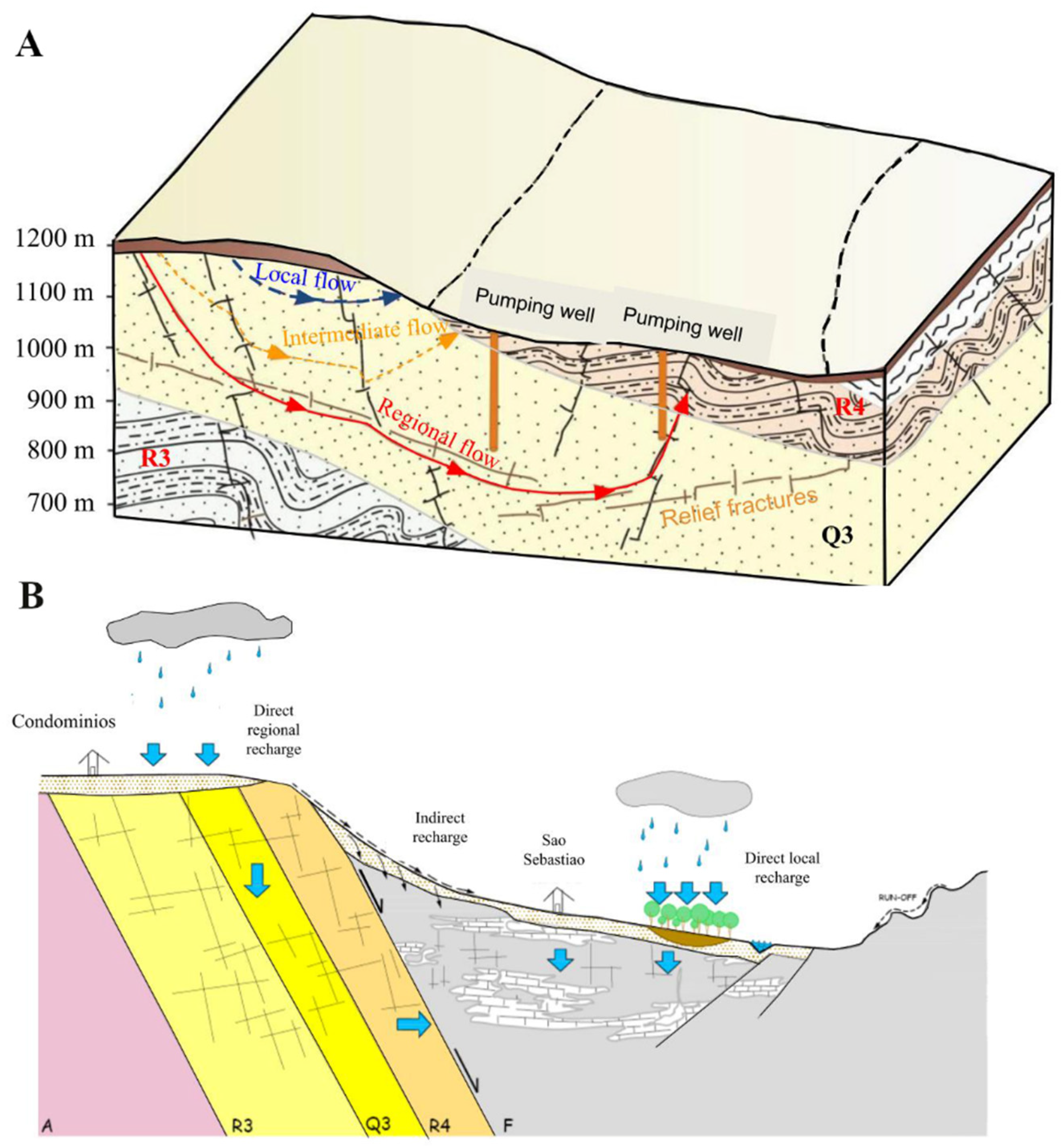
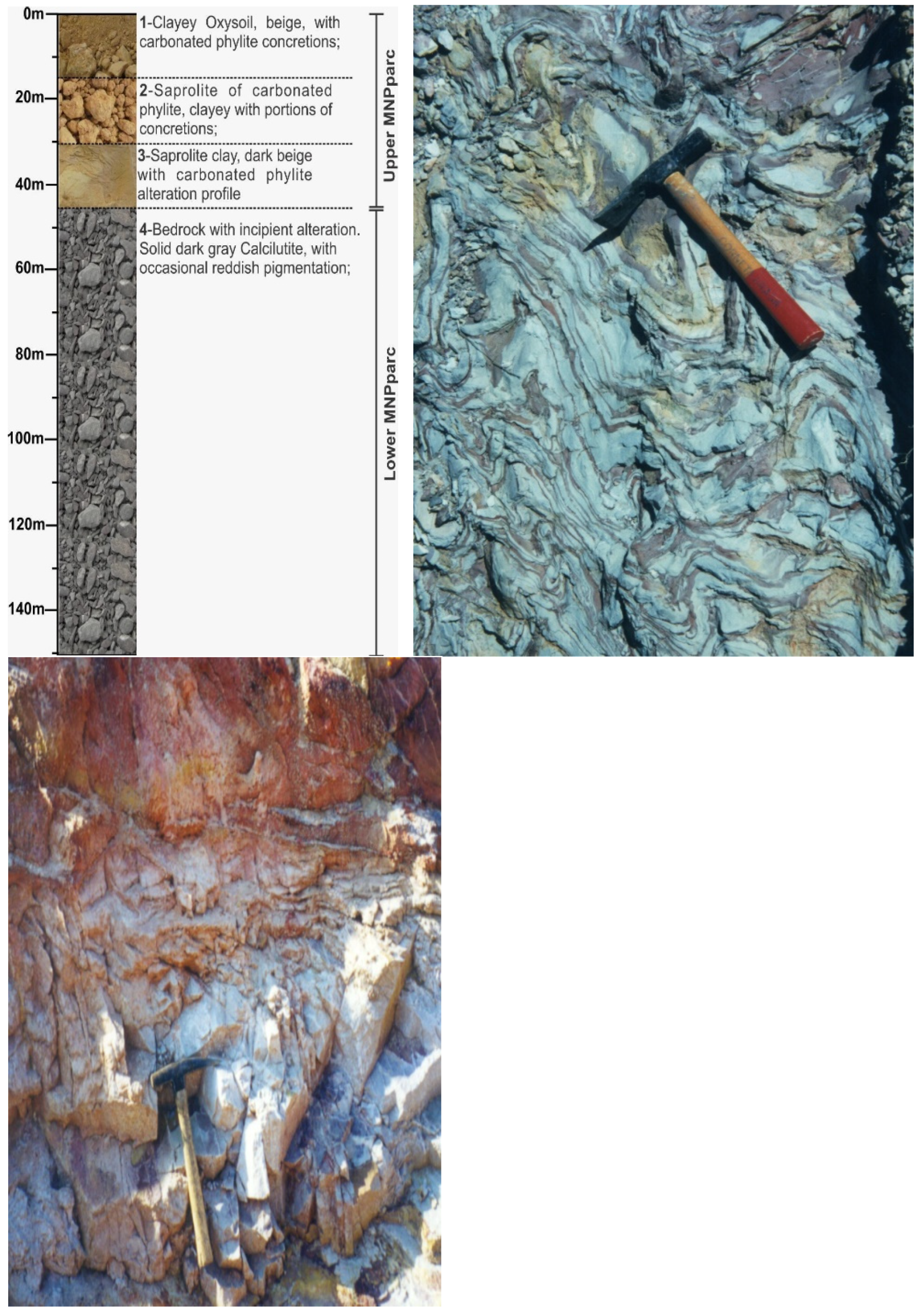

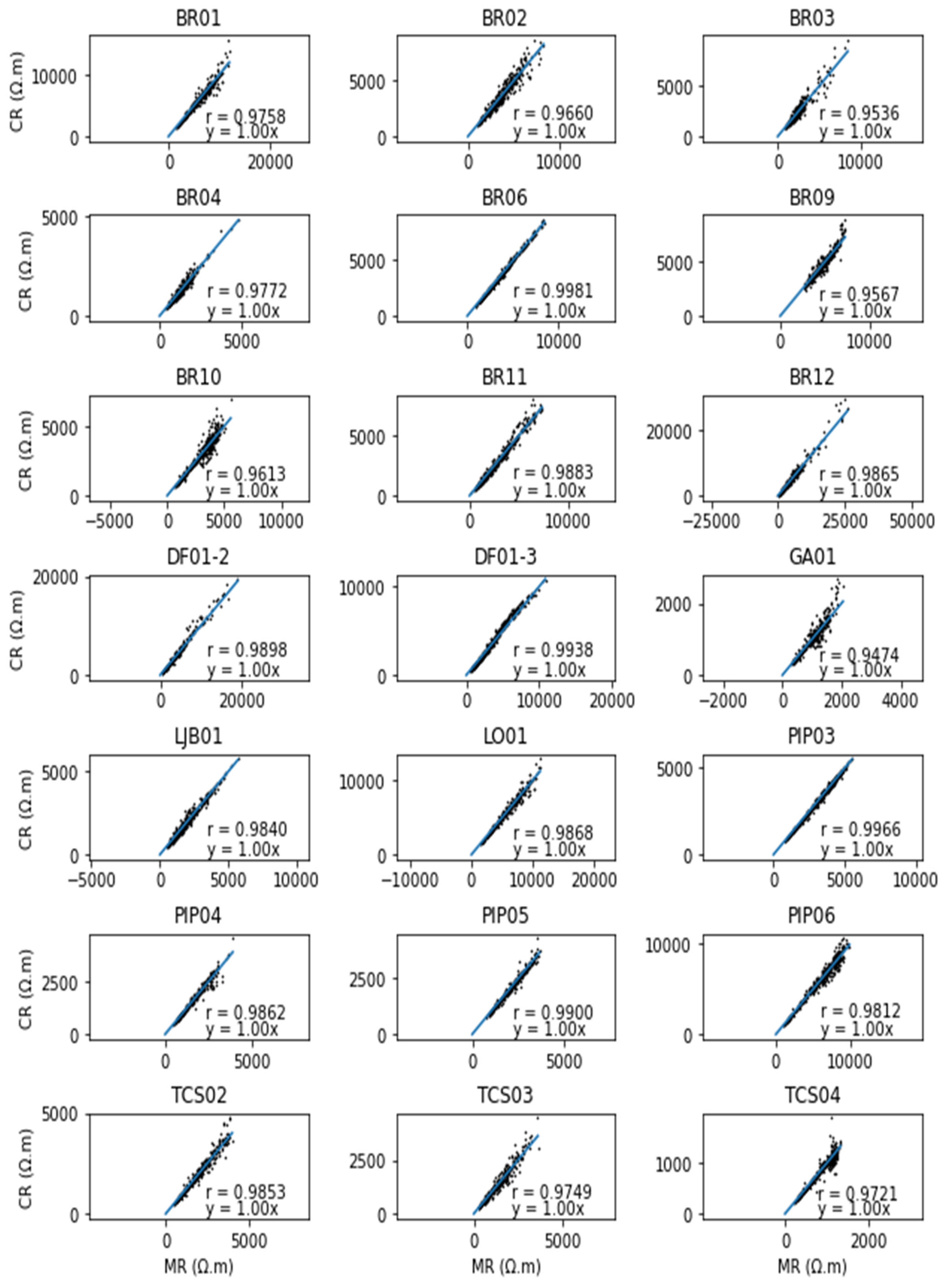
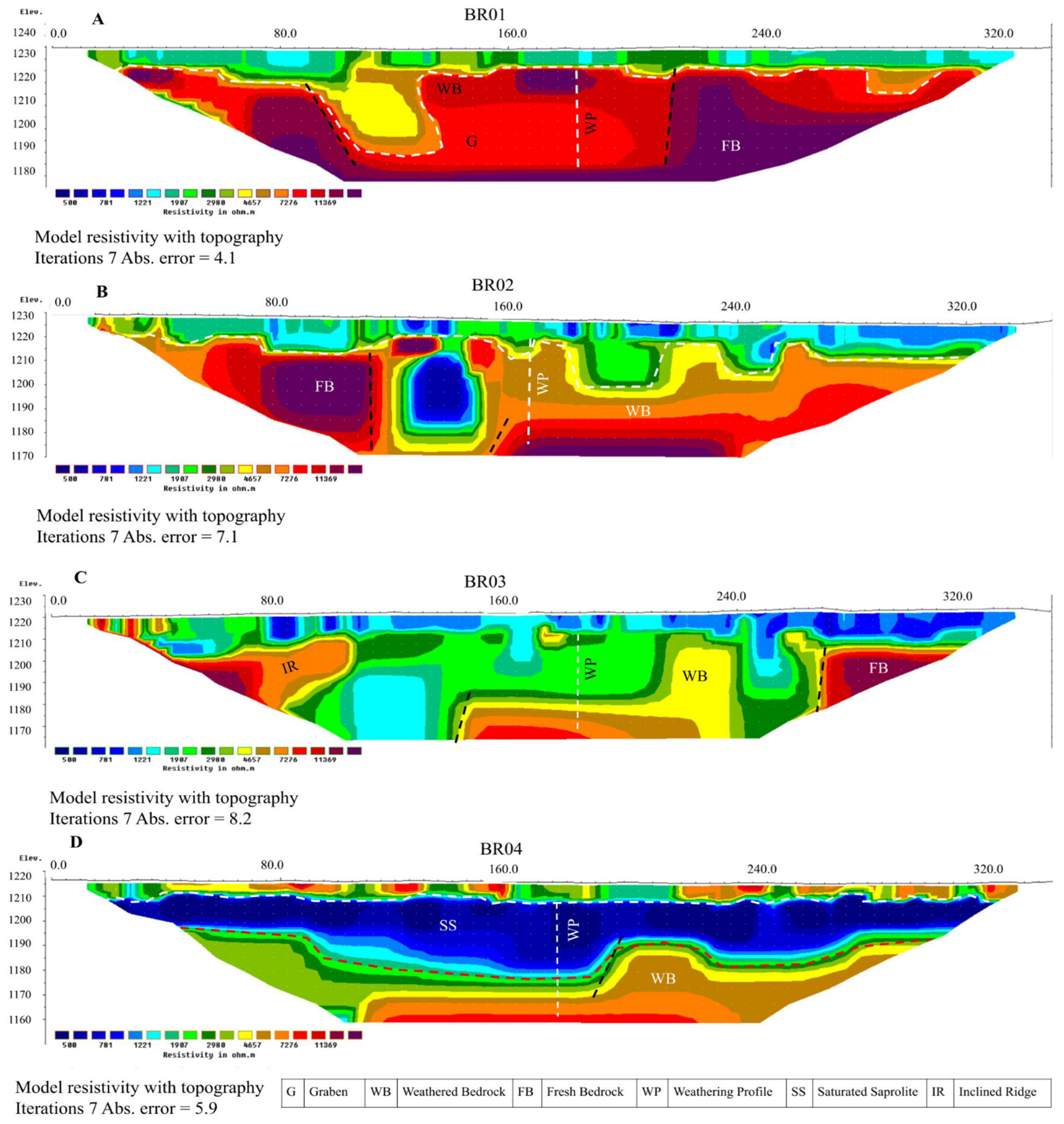
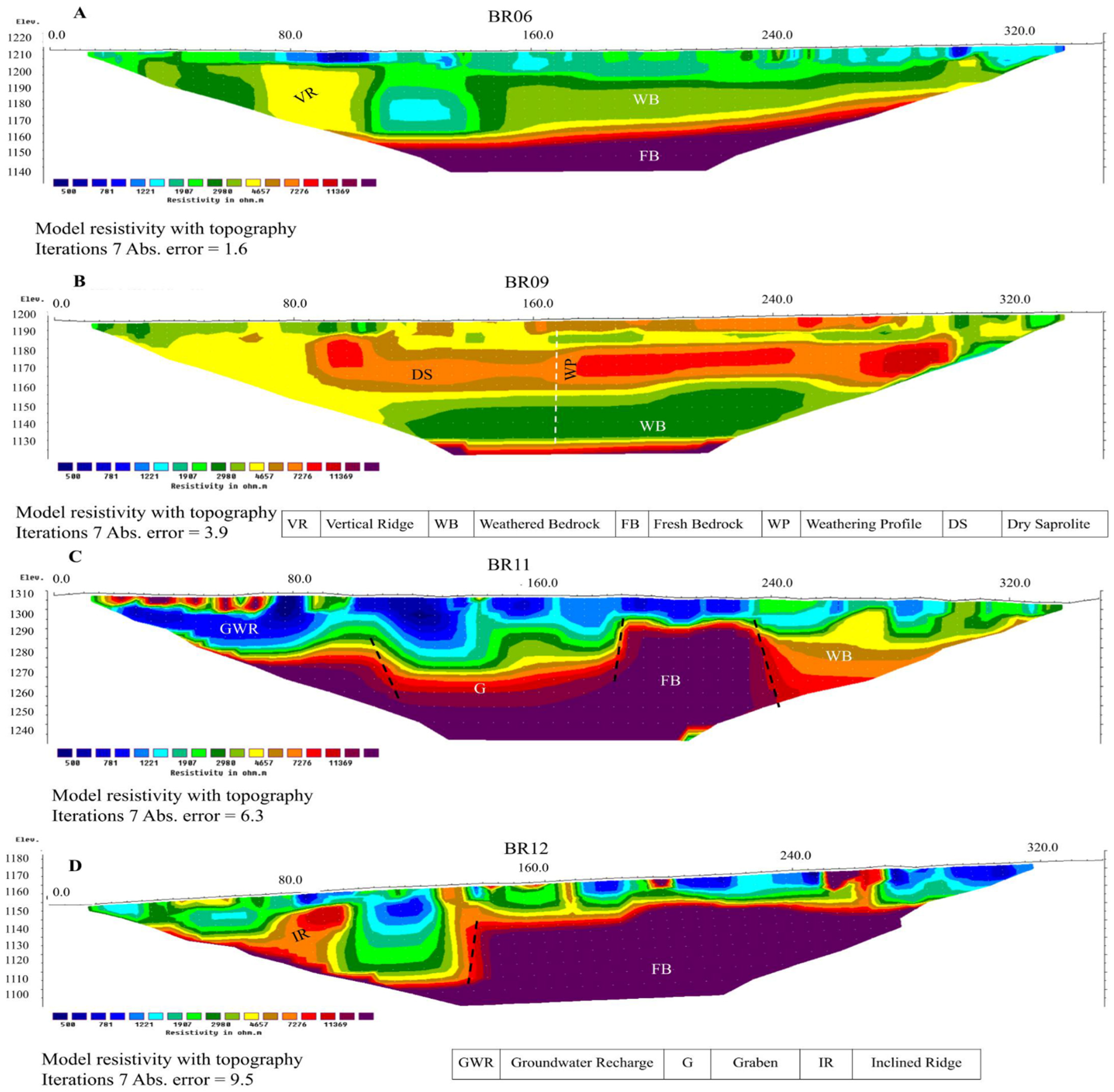
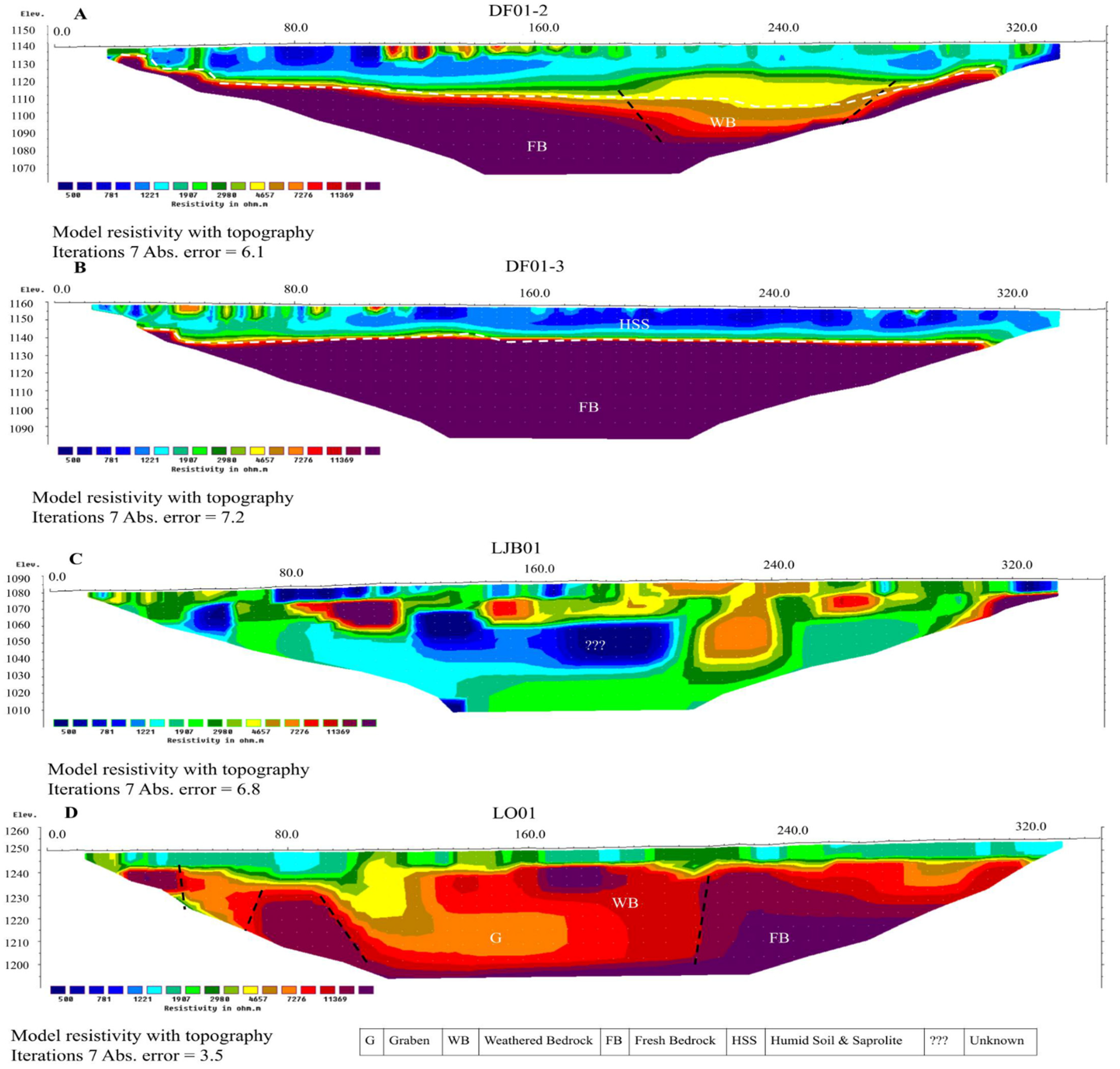

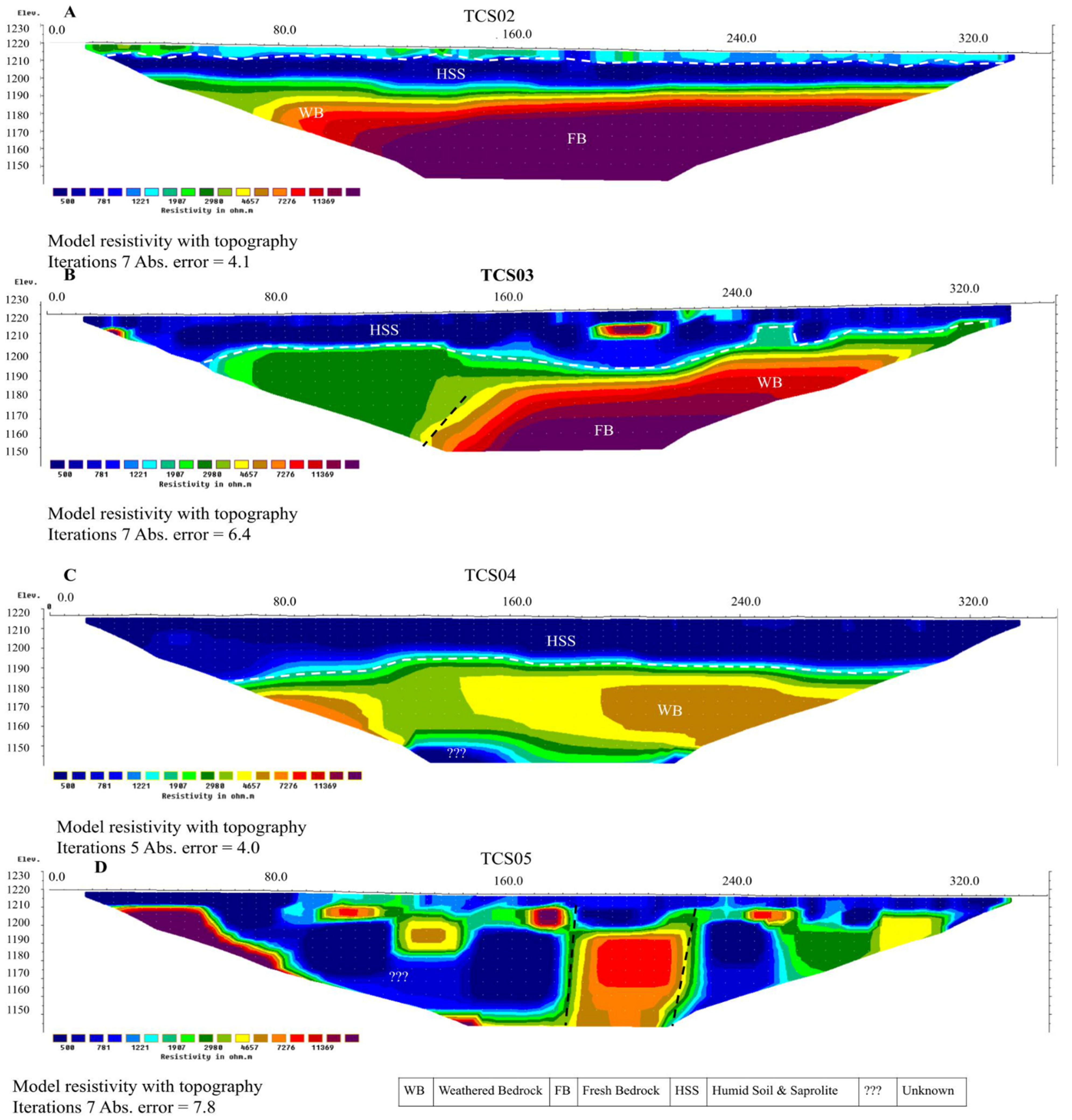

| Domain | System | Sub-System | Flow Rate (m3/h) | Lithology/Soil Type |
|---|---|---|---|---|
| Unconfined | System P1 | <0.8 | Sandy latosols and Quartzarenic Neosols | |
| System P2 | <0.5 | Clayey oxisols | ||
| System P3 | Plinthic and argillaceous | |||
| System P4 | <0.3 | Cambisol and Litholic Neosol | ||
| Fractured | Paranoa | S/A | 12.5 | Metasiltite |
| A | 4.5 | Slates | ||
| R3/Q3 | 12.0 | Sandy quartzites and metarhythmites | ||
| R4 | 6.5 | Clayey meta-rhythmites | ||
| Canastra | F | 7.5 | Micaceous phyllites | |
| Bambui | Topo | 6.0 | Silitos and Arcoses | |
| Araxa | - | 3.5 | Mica shales | |
| Fissured-Karstic | Paranoa | PPC | 9.0 | Metasiltites and marble lenses |
| Canastra | F/Q/M | 33.0 | Calciphyllites, quartzite and marbles | |
| Bumbui | Base | 9.0 | Silite and micritic limestone lenses |
| Units | R3 | Q3 | ||||
|---|---|---|---|---|---|---|
| Maximum | Minimum | Average | Maximum | Minimum | Average | |
| T(m2/s) | 7.8 × 10−4 | 1.2 × 10−4 | 4.9 × 10−4 | 1.4 × 10−3 | 1.4 × 10−4 | 4.0 × 10−4 |
| K(m/s) | 4.8 × 10−6 | 5.3 × 10−7 | 2.8 × 10−6 | 1.6 × 10−3 | 1.2 × 10−6 | 4.6 × 10−6 |
| S | 1.7 × 10−1 | 2 × 10−2 | 1.0 × 10−1 | 1.6 × 10−1 | 4.5 × 10−3 | 1.5 × 10−1 |
| Q(m3/h) | 48 | 0.0 | 12.5 | 42 | 0.0 | 12.4 |
Publisher’s Note: MDPI stays neutral with regard to jurisdictional claims in published maps and institutional affiliations. |
© 2022 by the authors. Licensee MDPI, Basel, Switzerland. This article is an open access article distributed under the terms and conditions of the Creative Commons Attribution (CC BY) license (https://creativecommons.org/licenses/by/4.0/).
Share and Cite
Hussain, Y.; Campos, J.E.G.; Borges, W.R.; Uagoda, R.E.S.; Hamza, O.; Havenith, H.-B. Hydrogeophysical Characterization of Fractured Aquifers for Groundwater Exploration in the Federal District of Brazil. Appl. Sci. 2022, 12, 2509. https://doi.org/10.3390/app12052509
Hussain Y, Campos JEG, Borges WR, Uagoda RES, Hamza O, Havenith H-B. Hydrogeophysical Characterization of Fractured Aquifers for Groundwater Exploration in the Federal District of Brazil. Applied Sciences. 2022; 12(5):2509. https://doi.org/10.3390/app12052509
Chicago/Turabian StyleHussain, Yawar, José Eloi Guimarães Campos, Welitom Rodrigues Borges, Rogério Elias Soares Uagoda, Omar Hamza, and Hans-Balder Havenith. 2022. "Hydrogeophysical Characterization of Fractured Aquifers for Groundwater Exploration in the Federal District of Brazil" Applied Sciences 12, no. 5: 2509. https://doi.org/10.3390/app12052509
APA StyleHussain, Y., Campos, J. E. G., Borges, W. R., Uagoda, R. E. S., Hamza, O., & Havenith, H.-B. (2022). Hydrogeophysical Characterization of Fractured Aquifers for Groundwater Exploration in the Federal District of Brazil. Applied Sciences, 12(5), 2509. https://doi.org/10.3390/app12052509











